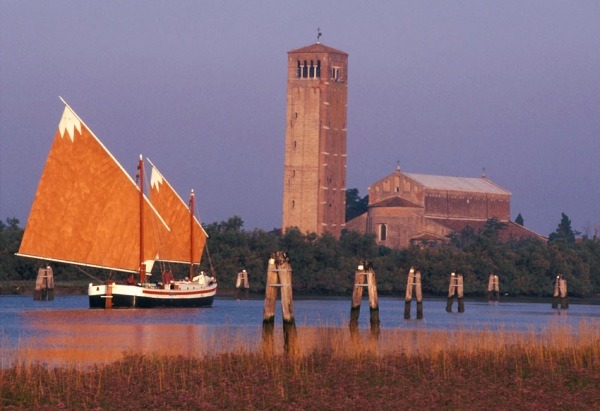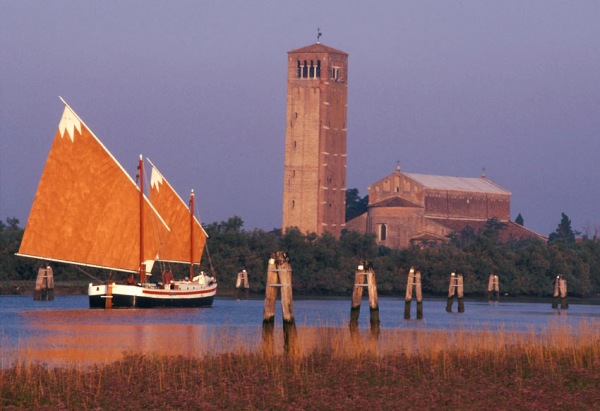Venice As The Tourists Never See It
Picture Venice at twilight on an autumn evening: The Rialto is thick with backpack-wearing, camera-wielding tourists wearing cargo shorts or sweat suits; the Piazza San Marco is a sea of pigeons, interrupted here and there by ranks of caffè tables where more tourists, maybe slightly better dressed, sip $12 espressos and listen to sour string orchestras play "The Theme from 'The Godfather'." You, meanwhile, are lounging in the stern of a 52-and-a-half-foot, 1946-vintage larchwood Venetian fishing boat beneath a billowing terra cotta-colored sail, cooled by gentle breezes as you sip a glass of icy prosecco while gliding past the brightly colored houses of Burano, the ancient lace-makers' island about a mile-and-a-half northeast of the pigeons and the cargo shorts. Who is having the more authentic Venetian experience?
When it comes to this one-of-a-kind city, says Mauro Stoppa, the Eolo's soft-spoken, avuncular-looking captain, "Everybody knows the canals, but they almost never notice the lagoon."
Venice itself is a collection of 117 tiny islands, mostly linked by footbridges, but it's only a small portion of an immense ecosystem that includes scores of other, larger islands, at least 30 of which are inhabited. Casual visitors to the city might take a day trip to Murano to visit one of the few remaining glass factories and buy gaudy, fragile souvenirs, or to neighboring Burano, where little lace is still produced but a fair amount is sold. If they're attending the Venice Film Festival, they'll get out to the Lido, a strand of sand and concrete (with cars!) at the mouth of the lagoon. They might possibly visit Torcello for lunch at the romantic Locanda Cipriani, where Hemingway once stayed and worked, or to
Our very word lagoon derives from the old Venetian name for this body of water, Laguna Veneta, lake of the Venetii. This particular "lake", which covers a little over 200 square miles (or 136,000 acres), is the largest wetland in the Mediterranean. Indeed, only ten percent of it or so is open water, with another eight percent dry land; the rest is marshland or mud flats. The water and the wetland are ecologically rich, full of plant and animal species not found anywhere else in quite the same form. (The lagoon's marshy fringes are full of the wild ducks and other game birds that are an unexpectedly important part of traditional Venetian cooking.)
The islands are diverse as well, as typified by San Francesco del Deserto, where a handful of Franciscan monks live and welcome overnight visitors; or San Lazzaro degli Armeni, one of the world capitals of Armenian culture since the 18th century (the library contains some 150,000 volumes; Lord Byron once studied there); or Sant'Erasmo, name-checked on all the best Venetian menus, which produces extraordinary vegetables, especially artichokes and peas.
Mauro Stoppa is the man to know if you want to discover these islands and other wonders of the lagoon. Born south of Venice near Chioggia, the main fishing town in the area, he has been sailing and fishing in these waters all his life. "The lagoon," he says, "is my sea." Stoppa is an agronomist by training, but about 15 years ago, he bought his historic boat, a kind of craft called a bragosso, whose design dates back to the time of the Doges. He restored and upgraded it, installing a galley and other amenities, and christened it the Eolo — the East Wind.
Stoppa is a serious cook. When I went out on the Eolo, some years back, our dinner included stuffed crab (fresh local crabmeat mixed with shreds of zucchini and artichokes, breadcrumbs, and thyme, a
go, an extraordinary roasted branzino that Stoppa had bought right off the boat from a fisherman he knows, and finally a simple dessert of ripe nectarines in cream with three kinds of homemade Venetian cookies.
The Eolo makes everything from daylong cruises to eight-day voyages —overnight accommodations are at inns or villas at various ports of call — for groups of at least six but no more than eight to 12 (depending on the program).
Food is always a major part of the adventure, including cooking classes and market visits, meals prepared and served by Stoppa and his crew, and, for the longer excursions, lunches and dinners ashore. A six- to eight-hour cruise with visits to numerous islands and an authentic Venetian meal on board runs €330 (about $455) per person; for another 20 euros ($27.50) per person, Stoppa will take guests shopping at the famous Rialto fish and produce markets, then give them a shipboard cooking lesson in addition to a meal.
The top-of-the-line offering, eight days involving villa stays, spectacular meals on board and off, a horse-and-buggy ride, a tour of sectet Venetian gardens, encounters with Venetian nobility, and a cruise along the Brenta canal, lined with stunning Palladian villas costs €5,800 (almost $8000) a head. That's a steep tariff — but the experience it offers is unparalleled, and is pretty much guaranteed to turn you into a Venetian insider, with an appreciation of the city and its surroundings that most visitors can't even imagine.
(All photos courtesy of Mark Edward Smith)

